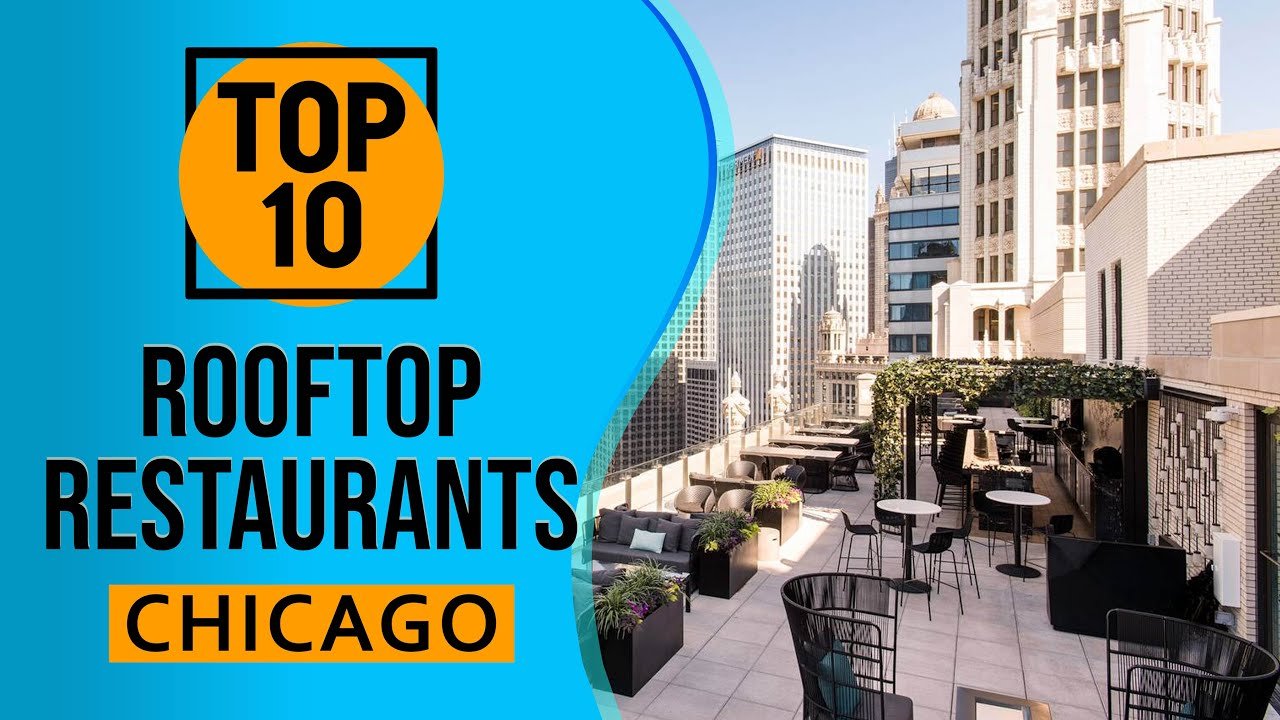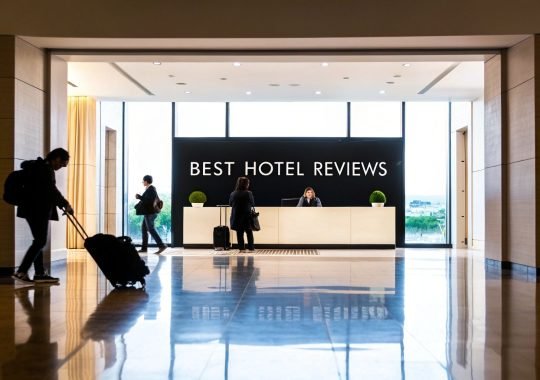Finding the perfect meal when you’re traveling can be a challenge. You’re in a new city, tired from your journey, and the sheer number of choices can feel overwhelming. The question of where to find quality restaurants near hotels is one every traveler faces, whether you’re looking for a quick bite before a meeting or a memorable dinner to cap off a day of sightseeing. Do you opt for the convenience of the hotel’s own restaurant, or venture out to find a local gem? This guide is designed to eliminate that guesswork and stress.
We’ll explore nine distinct types of dining options conveniently located near popular hotel districts, ensuring you can find the perfect meal to match your schedule, budget, and cravings. From the ease of in-house dining to the authentic flavors of local ethnic spots, consider this your roadmap to culinary satisfaction on your next trip. Our goal is to provide a structured approach to dining out, helping you make informed decisions quickly. For travelers seeking specific destination guides, exploring regional culinary scenes can be equally rewarding. For a broader look at an island’s culinary landscape and to discover some of the truly top dining experiences, dive into our guide to the best restaurants in Cyprus. This comprehensive list will help you dine well, no matter where your travels take you.
1. Hotel Restaurant/In-House Dining
The most convenient option when searching for restaurants near hotels is often right under your nose: the hotel’s own in-house dining. These establishments eliminate travel time, offering a seamless transition from your room to your table. The quality and style can vary dramatically, from casual grab-and-go cafes perfect for a quick breakfast to world-renowned, Michelin-starred fine dining experiences like The Palm Court at The Plaza Hotel in New York City.
Key Considerations for In-House Dining
Choosing to dine in-house is ideal for travelers on a tight schedule, those arriving late, or anyone seeking a low-effort, high-quality meal. Before you decide, it’s wise to check reviews for the restaurant specifically, as its quality may differ from the hotel’s overall rating. Don’t forget to inquire about potential discounts for hotel guests or special dining packages that may be available. For a truly hassle-free experience where all your meals are included, you might find that properties like the Hilton All Inclusive Resorts provide an excellent alternative, bundling accommodation and diverse culinary options into one price.
This summary box highlights the primary pros and cons of choosing your hotel’s restaurant.
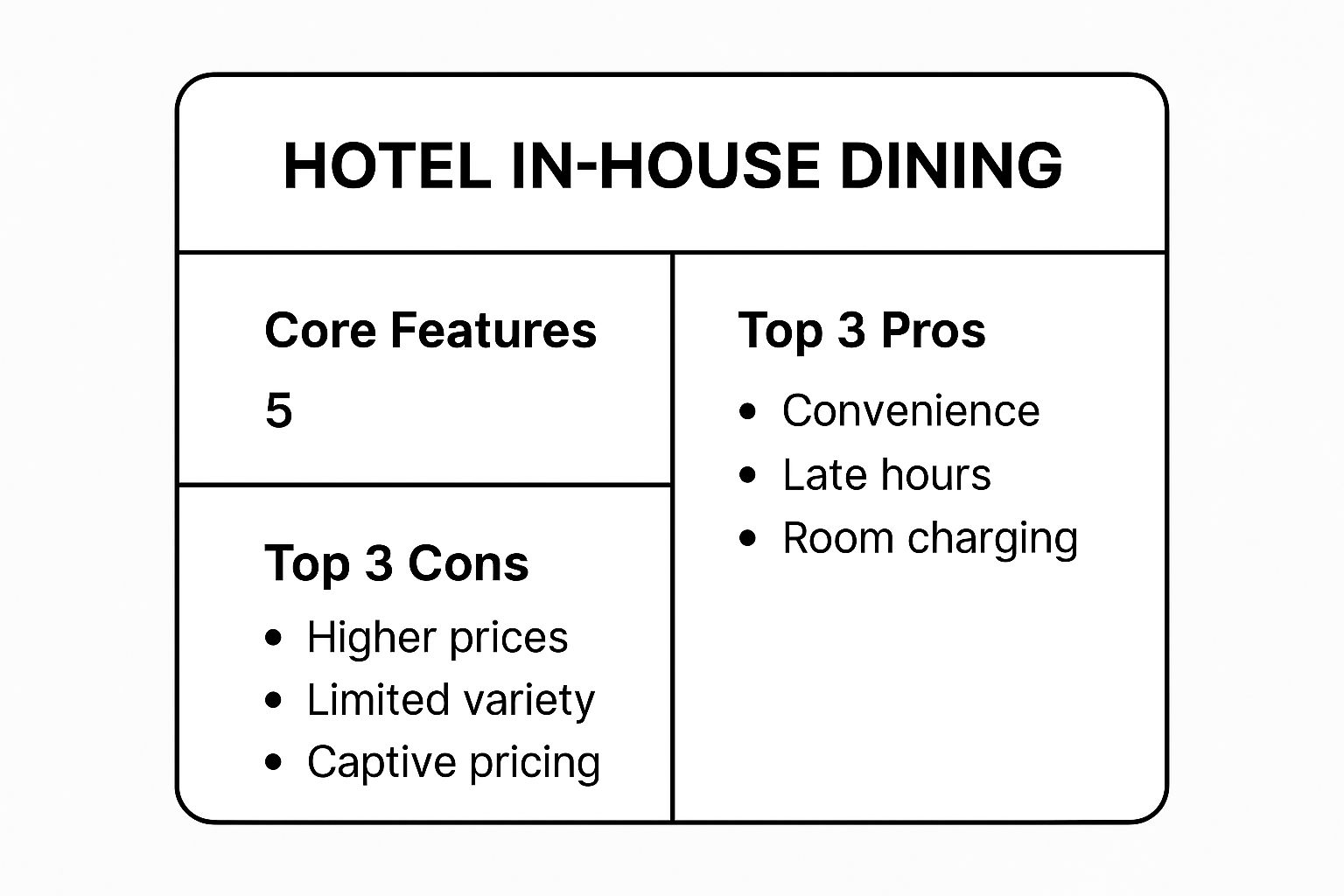
As the data shows, the primary benefit is undeniable convenience, though it may come at a higher cost with less variety than exploring local eateries.
Actionable Tips for Hotel Dining:
- Book Ahead: For upscale hotel restaurants, reservations are often essential, especially on weekends.
- Ask About Room Service: Confirm the hours for room service, as it provides a great backup option for late-night arrivals or early departures.
- Explore Menus Online: Most hotel restaurants post their menus on the hotel website, allowing you to check for variety and price before committing.
2. Walking Distance Casual Dining
Stepping just outside your hotel opens up a world of casual dining options that offer a fantastic balance of convenience, affordability, and local flavor. These restaurants, typically within a short 2-to-3 block walk, provide a welcome change of scenery from your hotel without the need for transportation. You can often find a mix of reliable national chains, such as an Applebee’s near an Embassy Suites, and charming local diners that give you a taste of the area’s authentic culture.
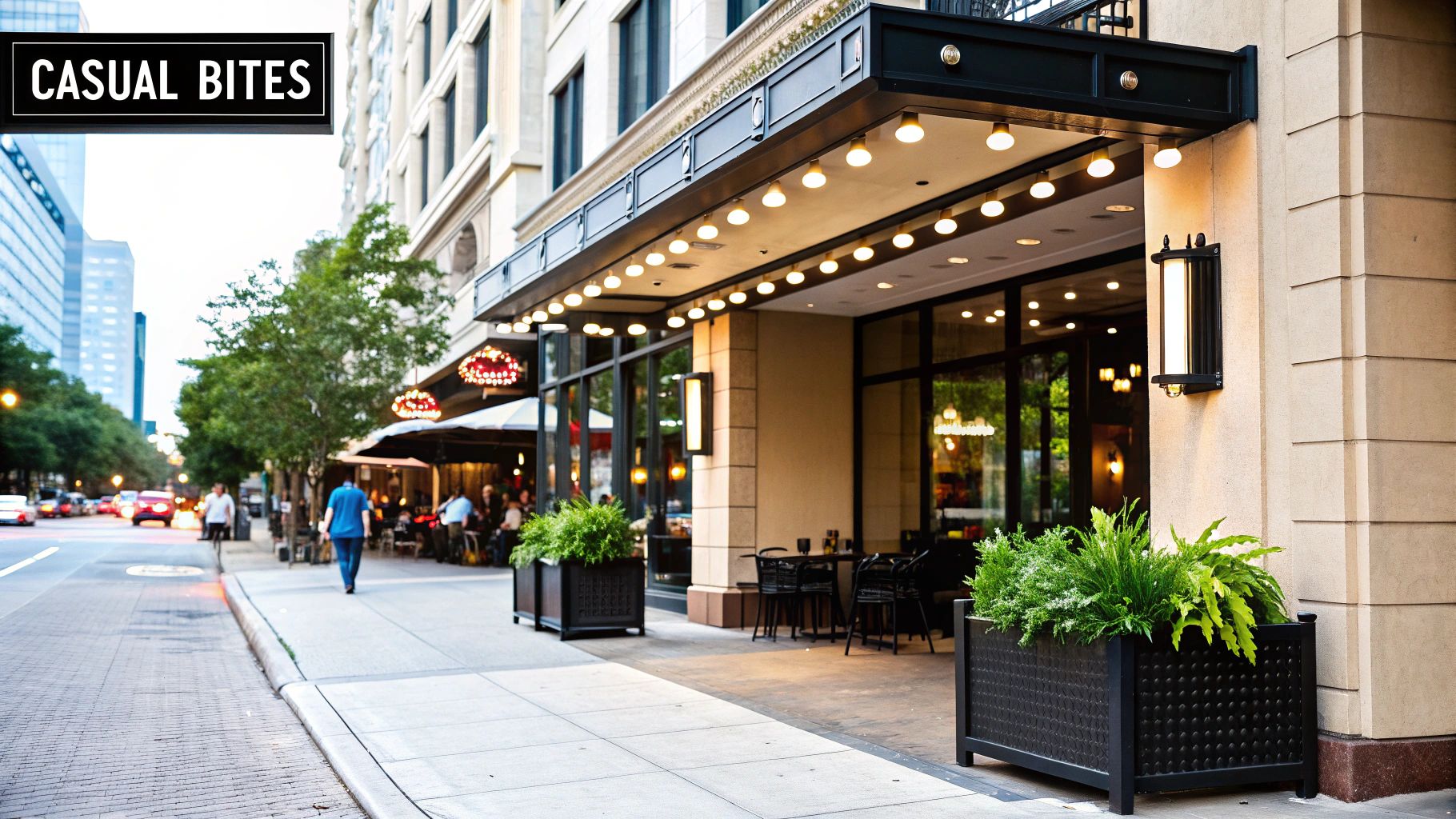
Key Considerations for Casual Walkable Eateries
Opting for a nearby casual restaurant is perfect for families, business travelers seeking a relaxed meal, or anyone wanting to stretch their legs and explore the immediate vicinity. These establishments are often more budget-friendly than in-house options and provide a greater variety of cuisines. Before you head out, a quick check of online reviews can save you from a disappointing meal. For instance, travelers staying in busy tourist hubs can discover a wealth of options, as seen in this guide to dining near the Floridian Express on International Drive, which highlights how easily accessible diverse restaurants can be.
This approach combines the ease of staying close with the benefit of experiencing the local dining scene.
Choosing a restaurant within walking distance allows you to enjoy a different atmosphere and often a more authentic or varied menu than the hotel restaurant, all while keeping your travel plans simple and cost-effective.
This summary box highlights the primary pros and cons of choosing a walkable casual restaurant.
As the data illustrates, the main advantages are cost savings and variety, though you sacrifice the ultimate convenience of dining just an elevator ride away.
Actionable Tips for Nearby Casual Dining:
- Consult the Concierge: Your hotel’s concierge is a valuable resource for vetted, up-to-date recommendations on the best casual spots nearby.
- Dine at Off-Peak Times: To avoid crowds and long waits, consider having an early lunch or a later dinner, especially in popular tourist areas.
- Look for Outdoor Seating: Choosing a restaurant with a patio or outdoor seating can enhance your dining experience, allowing you to enjoy the local ambiance and weather.
3. Fine Dining Within 5 Blocks
For travelers seeking a truly exceptional culinary experience, exploring fine dining establishments within a short walk of your accommodation is an excellent choice. These upscale restaurants near hotels often feature renowned chefs, sophisticated atmospheres, and meticulously sourced premium ingredients. They are perfect for celebrating a special occasion, entertaining important business clients, or simply indulging in a memorable meal.
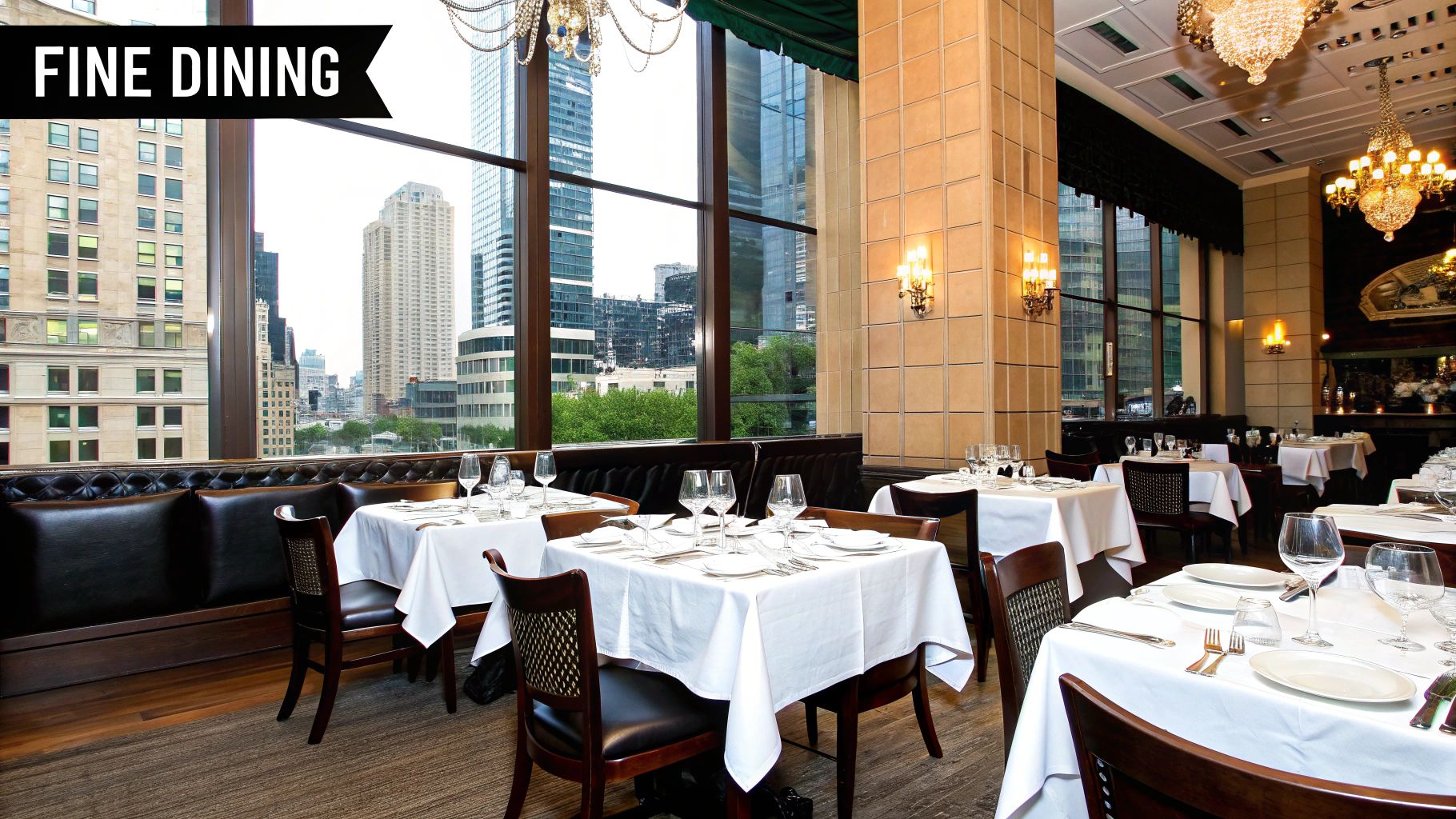
World-class cities are hubs for these culinary gems. For instance, guests at hotels in Midtown Manhattan are just blocks away from the legendary seafood at Le Bernardin, while those staying near the Flatiron District can aspire to a table at Eleven Madison Park. This proximity allows you to enjoy a high-end gastronomic adventure without the stress of navigating a new city.
Key Considerations for Fine Dining
Choosing a nearby fine dining restaurant is ideal when the meal itself is a central part of your travel experience. These venues offer more than just food; they provide an immersive event defined by impeccable service, artistic presentation, and a refined ambiance. While the cost is significantly higher, the value comes from the unparalleled quality and the creation of a lasting memory.
This summary box highlights the primary pros and cons of choosing a nearby fine dining restaurant.
The primary benefit is an unforgettable culinary event, though it requires advance planning and a significant budget.
Actionable Tips for Fine Dining:
- Make Reservations Well in Advance: Elite restaurants can be booked months ahead. Secure your table as soon as your travel dates are confirmed.
- Confirm Dress Code Requirements: Most fine dining establishments enforce a dress code, such as “business casual” or “jackets required.” Check their website or call ahead to avoid any issues.
- Budget for Pairings and Extras: The final bill can be substantially higher than the menu price. Factor in costs for wine pairings, cocktails, and optional supplements to the tasting menu.
4. Local Ethnic Restaurants
For a truly immersive cultural experience, one of the best categories of restaurants near hotels is the local ethnic eatery. These hidden gems, often found in vibrant immigrant neighborhoods or historic cultural districts, offer an authentic taste of a region’s culinary heritage. Venturing to these spots allows you to move beyond tourist-centric dining and sample traditional recipes passed down through generations. Think of the incredible dim sum in a bustling Chinatown, authentic pasta in a family-run Little Italy trattoria, or fiery Korean BBQ in Los Angeles’ Koreatown.
Key Considerations for Local Ethnic Restaurants
Choosing an authentic ethnic restaurant is perfect for the adventurous traveler looking to connect with the local culture through food. These establishments often provide better value and a more memorable experience than generic chains. To find the best spots, ask your hotel concierge or front desk staff for their personal favorites, as they often know the most authentic places that aren’t in every guidebook. Don’t be deterred by a language barrier; a friendly attitude and a translation app are usually all you need to navigate the menu and have a fantastic meal.
This summary box highlights the primary pros and cons of choosing a local ethnic restaurant.
As the data shows, these restaurants offer high authenticity and cultural value, though they may require a bit more effort to find and navigate than more conventional options.
Actionable Tips for Ethnic Dining:
- Ask for Recommendations: Inquire with hotel staff for their top picks for authentic cuisine. They can steer you away from tourist traps and toward genuine local favorites.
- Start with Popular Dishes: If the menu is unfamiliar, ask the server for the most popular or signature dishes. This is a great way to sample the best of what they offer.
- Be Adventurous (with Caution): Be open to trying new flavors, but don’t hesitate to ask about ingredients or spice levels if you have dietary restrictions or a sensitive palate.
5. 24-Hour Diners and Eateries
For travelers arriving on late-night flights, working odd hours, or battling jet lag, the classic 24-hour diner is a welcome sight. These round-the-clock eateries offer a reliable and comforting dining solution when most other restaurants near hotels have long since closed their doors. They specialize in familiar, unpretentious comfort food, providing a predictable menu that hits the spot at any hour, from a full breakfast at midnight to a burger for an early morning meal.
Key Considerations for 24-Hour Diners
Choosing a 24-hour diner is perfect for those with unconventional schedules or anyone craving a simple, satisfying meal without the formality of fine dining. These establishments, such as a classic Denny’s near a highway hotel or a bustling local diner in a city center, are staples for travelers seeking consistency and convenience. Before heading out late at night, it’s a good practice to call ahead or check their current hours online, as some locations may have adjusted their “24/7” service post-pandemic. They provide an invaluable service for anyone needing a dependable meal outside of standard dining times.
This summary box highlights the primary pros and cons of choosing a 24-hour diner.
As the data shows, the biggest advantages are constant availability and affordability, though the culinary experience is typically more functional than gourmet.
Actionable Tips for Diner Dining:
- Verify Late-Night Hours: Always confirm that the “24-hour” sign is still accurate. A quick phone call or a check on Google Maps can save you a late-night trip.
- Save the Location: If you know you’ll be arriving late, find a nearby diner in advance and save its location on your phone’s map for easy navigation when you’re tired.
- Embrace Breakfast for Dinner: One of the great joys of a diner is the all-day breakfast menu. Don’t hesitate to order pancakes or an omelet, regardless of the time.
6. Fast-Casual Chains
For travelers seeking a reliable and efficient meal, fast-casual chains offer a perfect middle ground between traditional fast food and a sit-down restaurant. These establishments are frequently found near hotels in business districts and bustling urban centers, providing familiar menus, consistent quality, and counter-service speed. The appeal lies in their ability to deliver customizable, often healthier, meals without the time commitment of full-service dining, making them one of the most dependable options for restaurants near hotels.
Key Considerations for Fast-Casual Chains
Opting for a fast-casual chain is an excellent strategy when you want a quick, predictable, and budget-friendly meal. Brands like Chipotle, Panera Bread, and Sweetgreen are known for fresh ingredients and made-to-order preparations, giving you control over your meal. This makes them a great fit for travelers with dietary restrictions or those simply craving a quality salad, bowl, or sandwich. Before heading out, check the chain’s official app, as many offer order-ahead features that let you bypass the line entirely, a huge time-saver for a busy traveler.
This summary box highlights the primary pros and cons of choosing a fast-casual chain.
The primary benefit is the blend of speed, quality, and affordability, though the experience lacks the unique local flavor you might find elsewhere.
Actionable Tips for Fast-Casual Dining:
- Use Mobile Apps: Download the restaurant’s app to order and pay in advance. Your meal will often be waiting for you on a designated pickup shelf, saving valuable time.
- Look for Loyalty Programs: Many chains have loyalty programs that offer free items or discounts after a few visits, which is beneficial for frequent business travelers.
- Check for Limited-Time Offers: These chains often feature seasonal or regional specialty items that provide a chance to try something new beyond the standard menu.
7. Hotel Lobby Bars and Lounges
Often overlooked as mere waiting areas, hotel lobby bars and lounges are sophisticated dining destinations in their own right. These venues offer more than just drinks; they provide elegant atmospheres perfect for light meals, pre-dinner cocktails, or casual business meetings. The menu typically features a curated selection of small plates, artisan cheeses, and gourmet bites designed to complement an extensive list of craft cocktails and premium spirits. Renowned examples like The King Cole Bar at The St. Regis in New York City or Artesian at The Langham in London showcase how these spaces can become iconic culinary hotspots.
Key Considerations for Lobby Bars and Lounges
Choosing a hotel lobby bar is an excellent option for travelers seeking a stylish yet relaxed environment without committing to a full-course meal. They are perfect for solo diners, couples looking for an intimate setting, or professionals needing a polished space to network. Before settling in, it’s worth checking the menu online to ensure the food offerings match your appetite. While many are walk-in friendly, prestigious or popular hotel lounges often require reservations, especially during peak evening hours. The sophisticated ambiance also means a smart-casual dress code is often expected.
This summary box highlights the primary pros and cons of choosing a hotel lobby bar or lounge.

As the data suggests, these venues provide a chic and convenient experience, though the food menu may be less extensive and the cost higher than more casual restaurants near hotels.
Actionable Tips for Lobby Bar Dining:
- Check Happy Hour Specials: Many hotel bars offer excellent happy hour deals on drinks and appetizers, providing great value in an upscale setting.
- Ask About Signature Cocktails: Bartenders in these establishments are often highly skilled mixologists. Don’t hesitate to ask for their signature creation or a recommendation based on your preferences.
- Dress Appropriately: To match the sophisticated atmosphere, adhere to a smart-casual or business-casual dress code. Avoid overly casual attire like shorts and flip-flops.
8. Rooftop Restaurants
For a dining experience that elevates your trip, both literally and figuratively, rooftop restaurants offer a memorable option. These establishments, often found atop hotels or high-rise buildings, provide stunning panoramic views of the city skyline, making them one of the most scenic choices when looking for restaurants near hotels. The atmosphere is typically vibrant and sophisticated, perfect for a special occasion, a romantic evening, or simply to capture that perfect Instagram-worthy shot.
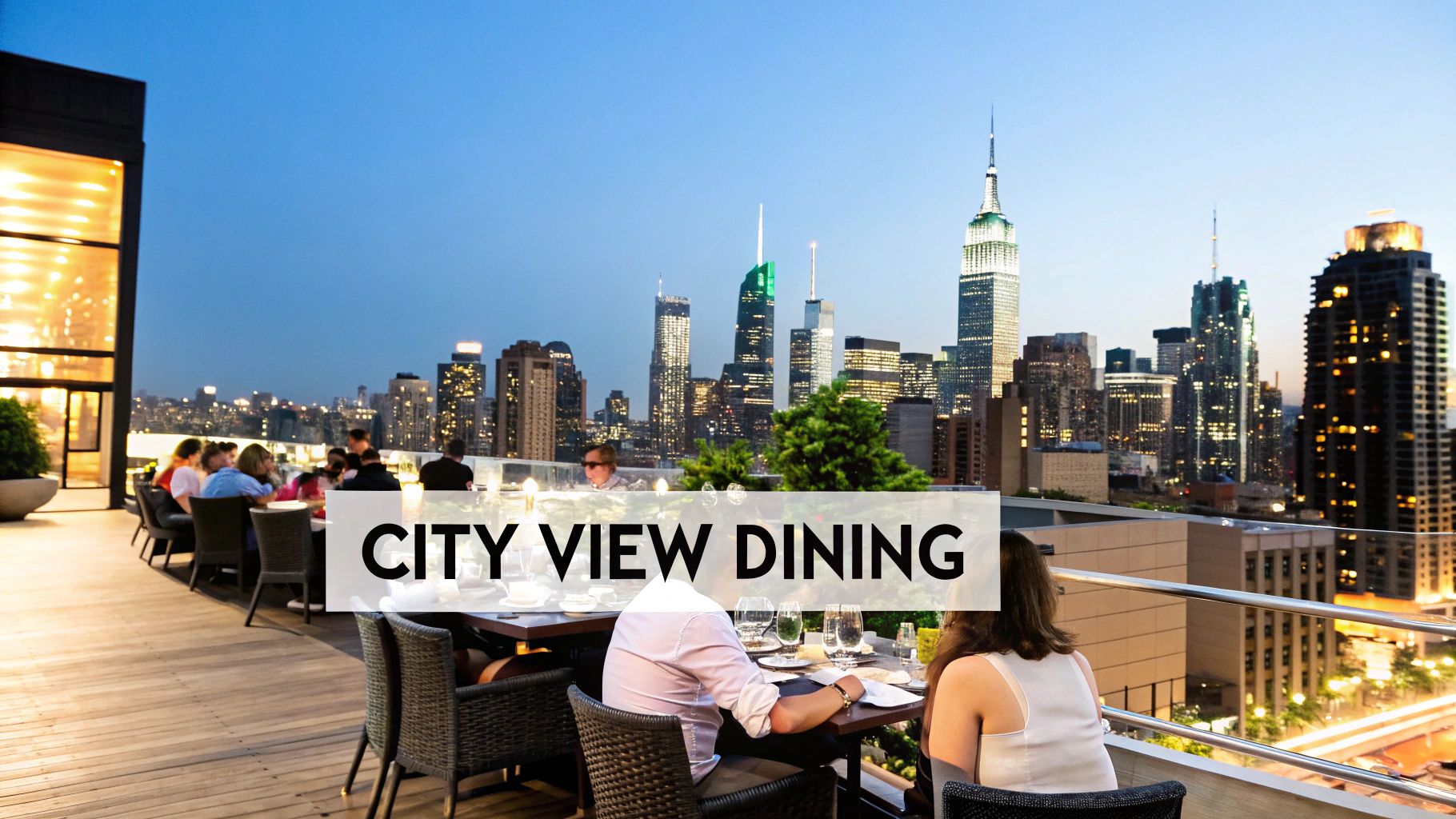
Popular examples include 230 Fifth in New York City, which offers incredible views of the Empire State Building, and Skye Bar in Los Angeles, known for its chic ambiance and sweeping city vistas. These venues combine creative cocktails and gourmet menus with an unparalleled backdrop, turning a simple meal into an unforgettable event.
Key Considerations for Rooftop Restaurants
Choosing a rooftop restaurant is ideal for travelers seeking a unique dining atmosphere and breathtaking views that you can’t get from a ground-level eatery. Before you go, it’s essential to check the weather forecast, as wind or rain can impact the outdoor experience. Many venues have indoor sections, but the main draw is the open-air setting. To see how a city like Barcelona masters this concept, you can find more inspiration for your next trip and learn more about rooftop dining in Barcelona.
This video showcases the stunning views and unique atmosphere you can expect from a top-tier rooftop dining experience.
As you can see, the combination of great food, inventive drinks, and spectacular scenery makes rooftop restaurants a top choice for a memorable night out.
Actionable Tips for Rooftop Dining:
- Make Reservations: Rooftop spots are incredibly popular. Book a table well in advance, especially if you want to dine during sunset hours.
- Arrive Before Sunset: For the best of both worlds, plan to arrive before the sun goes down to enjoy the transition from daylight to a sparkling city nightscape.
- Dress in Layers: Even on a warm day, it can get chilly and windy high above the city streets once the sun sets. Bringing a light jacket or sweater is always a good idea.
9. Food Halls and Markets
For travelers seeking variety and a taste of local culture, food halls and markets are an unbeatable option. These bustling indoor venues gather numerous independent food vendors under one roof, creating a vibrant culinary hub. This setup allows you to explore a wide array of cuisines in a single location, making them one of the most dynamic choices for finding excellent restaurants near hotels. Iconic examples include Chelsea Market in New York City or Philadelphia’s historic Reading Terminal Market, both offering everything from artisanal cheese and fresh seafood to gourmet tacos and handcrafted pastries.
Key Considerations for Food Halls and Markets
Choosing a food hall is perfect for groups with diverse tastes, indecisive diners, or anyone wanting to sample multiple local specialties without committing to a full meal at one place. The communal seating and lively atmosphere provide a more casual and social dining experience than a traditional restaurant. Before you go, check the market’s hours, as they can vary, and look at the vendor directory online to get a sense of the offerings. While many vendors now accept cards, it’s always a good idea to bring some cash, especially for smaller, independent stalls.
This summary box highlights the primary pros and cons of choosing a food hall or market.
The main advantage is the incredible variety and the opportunity to experience local flavors, though the bustling environment can be overwhelming during peak times, and finding seating can sometimes be a challenge.
Actionable Tips for Food Halls and Markets:
- Go During Off-Peak Hours: To avoid large crowds and long lines, try visiting on a weekday afternoon or for an early dinner.
- Do a Lap First: Walk through the entire market to see all your options before you make a purchase. This helps you discover hidden gems and make an informed choice.
- Mix and Match: The best part of a food hall is the variety. Get an appetizer from one vendor, a main course from another, and dessert from a third to create a unique, customized meal.
9-Category Dining Options Comparison
| Dining Option | Implementation Complexity 🔄 | Resource Requirements ⚡ | Expected Outcomes 📊 | Ideal Use Cases 💡 | Key Advantages ⭐ |
|---|---|---|---|---|---|
| Hotel Restaurant/In-House Dining | Medium – requires in-house staff & kitchen | High – full kitchen, trained staff, inventory | High-quality convenient dining experience | Travelers valuing convenience, business trips, luxury dining | Maximum convenience, late hours, room charging |
| Walking Distance Casual Dining | Low – no hotel involvement | Low – relies on nearby existing restaurants | Reliable, casual meal with moderate variety | Families, budget travelers, casual dining near hotel | Easy accessibility, reasonable prices, family-friendly |
| Fine Dining Within 5 Blocks | Medium – reservations & dress code enforcement | Medium – requires advance planning, upscale setting | Exceptional culinary experiences | Business entertainment, celebrations, food enthusiasts | High-quality food, impressive atmosphere, professional service |
| Local Ethnic Restaurants | Low – independent local businesses | Low – local ingredients, traditional staffing | Authentic cultural and culinary immersion | Cultural explorers, adventurous eaters | Authentic flavors, excellent value, local business support |
| 24-Hour Diners and Eateries | Low – staff shifts for 24/7 operation | Medium – continuous staffing and supplies | Always available comfort food options | Late arrivals, shift workers, travelers with irregular schedules | 24/7 availability, comfort food, no reservations needed |
| Fast-Casual Chains | Low – standardized operations | Medium – supply chains, consistent training | Quick, predictable, and healthy meals | Quick meals, health-conscious travelers, families | Predictable quality, fast service, mobile ordering |
| Hotel Lobby Bars and Lounges | Medium – bar staffing & service standards | Medium – premium spirits, small kitchen | Elegant social and business meeting spaces | Networking, cocktail enthusiasts, pre-dinner drinks | Convenient location, quality cocktails, business-friendly |
| Rooftop Restaurants | High – weather dependency, outdoor setup | High – premium location, reservation system | Memorable dining with panoramic views | Special occasions, romantic dinners, Instagram-worthy experiences | Spectacular views, unique atmosphere, romantic setting |
| Food Halls and Markets | Medium – multi-vendor coordination | Low-Medium – shared seating, vendor management | Diverse, flexible dining experiences | Groups, food explorers, casual sampling of local specialties | Wide variety, local vendors, casual and social environment |
Choosing Your Perfect Plate: Final Thoughts
Your dining choices are more than just a necessity when traveling; they are a pivotal part of the experience, capable of transforming a simple meal into a cherished memory. As this guide has illustrated, the landscape of restaurants near hotels is incredibly rich and varied, offering a perfect plate for every palate, schedule, and budget. The key to unlocking a truly satisfying culinary journey lies not just in knowing what’s available, but in strategically aligning your dining decisions with the unique context of your trip.
By moving beyond the default choice, you open up a world of possibilities. The convenience of in-house hotel dining is undeniable for a busy traveler, while a short stroll to a casual eatery provides a welcome change of scenery and a taste of local life. For those special occasions, a fine dining establishment just a few blocks away can elevate your entire trip.
Recapping Your Culinary Options
Let’s quickly revisit the diverse dining categories we’ve explored. Each serves a distinct purpose and can enhance your travel in different ways:
- Ultimate Convenience: Hotel restaurants, lobby bars, and even some fast-casual chains offer reliability and save precious time, perfect for business trips or arrival days.
- Local Immersion: Seeking out neighborhood ethnic restaurants, bustling food halls, or beloved 24-hour diners allows you to eat like a local and discover authentic flavors you won’t find anywhere else.
- Elevated Experiences: Rooftop restaurants provide breathtaking views and a memorable atmosphere, while fine dining establishments deliver impeccable service and world-class cuisine for a truly special night out.
The most important takeaway is to be intentional. Before you open a delivery app or settle for the first place you see, take a moment to consider what you truly want from your meal. Are you seeking comfort after a long day of travel, or are you craving a culinary adventure that pushes your boundaries?
A Strategic Approach to Dining While Traveling
Mastering the art of choosing the right restaurant is a valuable travel skill. It’s about optimizing your time, budget, and overall enjoyment. A well-chosen meal can energize you for a day of sightseeing, provide the perfect backdrop for a business meeting, or become the romantic highlight of a getaway. The reverse is also true; a poor dining experience can leave you feeling disappointed and unfulfilled.
To put this into practice, consider creating a loose “dining itinerary” for your next trip.
- Arrival Day: Prioritize ease. An in-house hotel restaurant or a reliable walking-distance spot is ideal.
- Exploration Day: Be adventurous. Plan to visit a local food market for lunch or a highly-rated ethnic restaurant for dinner.
- Special Occasion: Book in advance. If you have something to celebrate, secure a reservation at a fine dining or rooftop restaurant.
For travelers visiting a global culinary hub like Dubai, the options expand exponentially. To get a sense of the broader landscape beyond just what’s near your hotel, you might want to Discover the best restaurants in Dubai for a comprehensive look at the city’s most acclaimed dining spots. This kind of research helps you understand the local food scene on a deeper level.
Ultimately, the power to craft an exceptional travel experience is in your hands. By thoughtfully selecting from the myriad of restaurants near hotels, you ensure that every meal contributes positively to your journey, turning simple sustenance into a series of delightful discoveries.
Ready to plan your next trip and discover the amazing dining that awaits? Use HotelsEscape to find the perfect accommodation situated in the heart of the world’s most vibrant culinary scenes. With our curated hotel selections and destination guides, HotelsEscape makes it easy to book a stay where great food is always just steps away.
